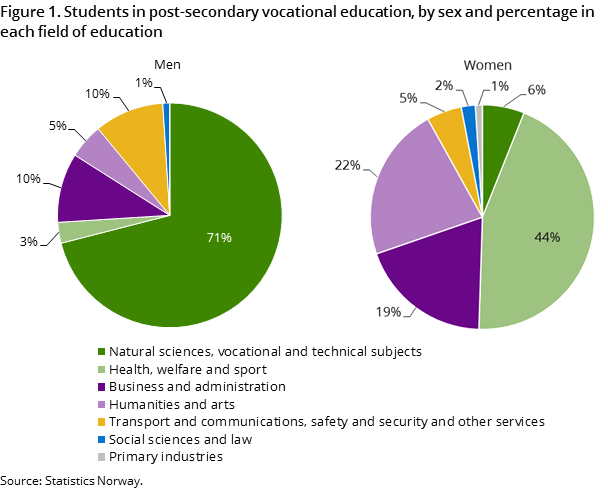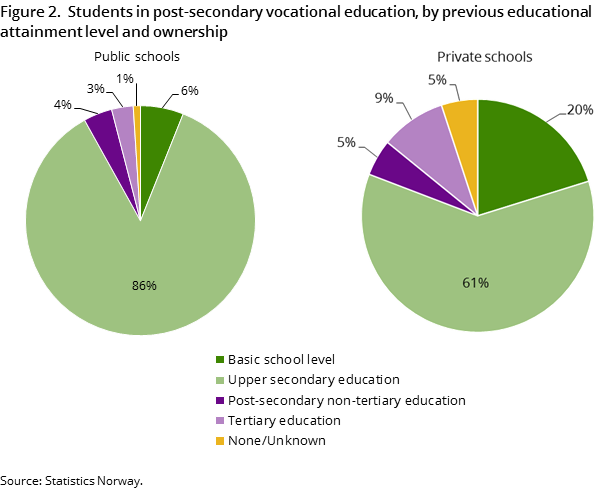Content
Published:
This is an archived release.
Large gender differences in field of study
A total of 15 200 students were registered in post-secondary vocational education as per 1 October 2014. Sixty-two per cent of these students are men. The largest field of education is Natural sciences, vocational and technical subjects, which has 7 100 students. Seventy-one per cent of male students are registered in this field of education, compared with 6 per cent of female students.
| 2014 | 2013 | Change | |
|---|---|---|---|
| 2013 - 2014 | |||
| Number of students | 15 249 | 15 495 | -246 |
| Per cent women | 38 | 38 | 0 |
| Per cent in public schools | 50 | 46 | 4 |
| Number of students in field of education | |||
| Humanities and arts | 1 725 | 2 408 | -683 |
| Social sciences and law | 229 | 609 | -380 |
| Business and administration | 2 053 | 2 217 | -164 |
| Natural sciences, vocational and technical subjects | 7 069 | 6 987 | 82 |
| Health, welfare and sport | 2 764 | 2 117 | 647 |
| Primary industries | 99 | 108 | -9 |
| Transport and communications, safty and security and other services | 1 310 | 1 049 | 261 |


The field of education most dominated by women is Health, welfare and sport, which is the second largest field of education among the post-secondary vocational education programmes. Forty-four per cent of female students are taking programmes in Health, welfare and sport, compared with three per cent of male students. Thus, there is a pronounced gender difference in choice of field of education.
Public schools have more technical subjects
Half of all students are registered in a public school, but there is a clear gender difference. While 66 per cent of male students attend public schools, only 23 per cent of female students do the same.
This may be related to the subjects offered, as three quarters of students in public schools take programmes in Natural sciences, vocational and technical subjects. In private schools, less than a fifth of students are registered in this field of education.
One in five are over 40 years old
Most students in post-secondary vocational education are over the age of 20, which is to be expected since this level of education builds on upper secondary education.
Two in five students are 25 years or younger, but the age structure of the students indicates that a break between upper secondary education and post-secondary vocational education is common. Forty-one per cent of students are over the age of 30, and almost one in five are over 40.
Few have post-secondary vocational education as highest level of education
Post-secondary vocational education is a small level in the Norwegian education system. The total number of students in 2014 was 15 200, compared with 198 200 in upper secondary education and 272 500 in tertiary education. Approximately 53 600 people over the age of 16 had post-secondary vocational education as their highest level of education in 2013, which constitutes 1.3 per cent of the population in the same age group.
This level was the highest level of education for 2.1 per cent of men and 0.5 per cent of women. However, post-secondary vocational education has only been registered since 2005, and is a relatively new level of education.
Most students have completed upper secondary
A requirement for entrance to post-secondary vocational schools is completion of upper secondary education or an equivalent qualification. Of the 15 400 students registered in autumn 2013, 83 per cent had completed a minimum of upper secondary school, while 14 per cent had lower secondary school as their highest level of education.
Almost eight in ten students registered with a maximum of lower secondary education prior to entering post-secondary vocational education attended private schools. Approximately 1 000 students had previously completed tertiary education, and 76 per cent of these went to private schools.
Almost half of the students have completed within two years
Of the 7 800 students who started post-secondary vocational education for the first time in 2010, 46 per cent had completed within two years, and a further 7 per cent completed within five years.
Fifty-two per cent of men completed within the five-year period, compared with 54 per cent of women.
Women the majority among immigrants
One in ten students are immigrants or Norwegian-born children of immigrant parents. Women account for 55 per cent of immigrant students, while men are in a clear majority among other students. Half of the other students attend public schools, compared with 36 per cent of immigrants.
Parents often have upper secondary education
Almost half of the students in post-secondary vocational education have parents whose highest level of education is upper secondary school. Thirteen per cent have parents with a basic education, and 28 per cent have parents with a tertiary education.
In comparison, 49 per cent of students at Norwegian universities and colleges have parents with a tertiary education, 35 per cent have upper secondary education and 6 per cent have a basic education.
Contact
-
Jane Bekkengen
E-mail: jane.hansine.bekkengen@ssb.no
tel.: (+47) 40 81 13 52
-
Geir Nygård
E-mail: geir.nygard@ssb.no
tel.: (+47) 48 15 13 44
